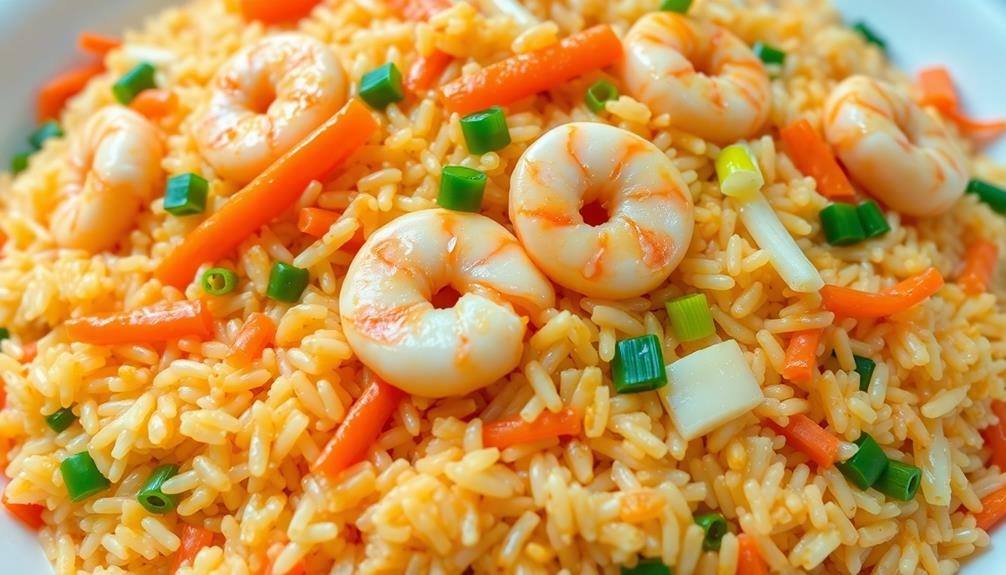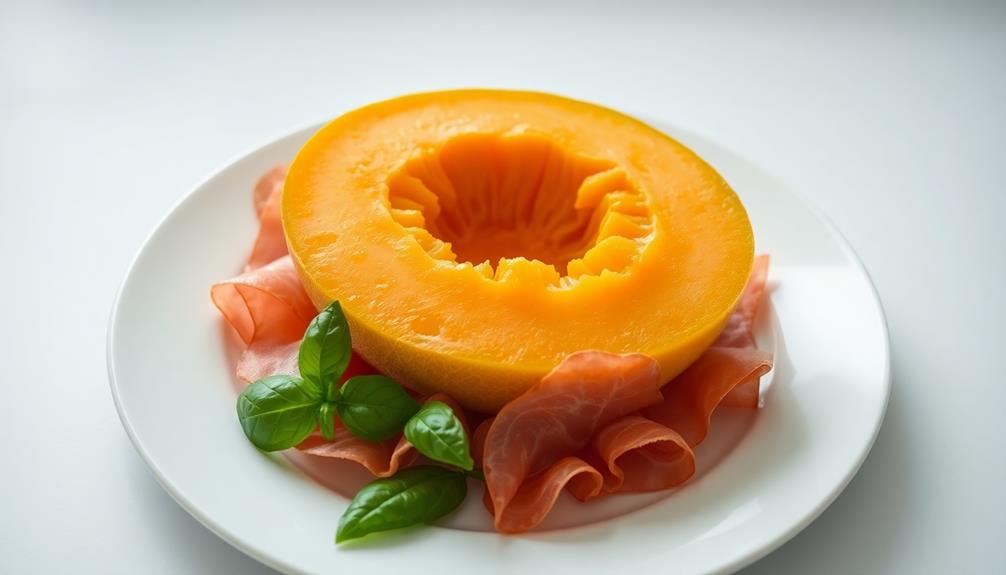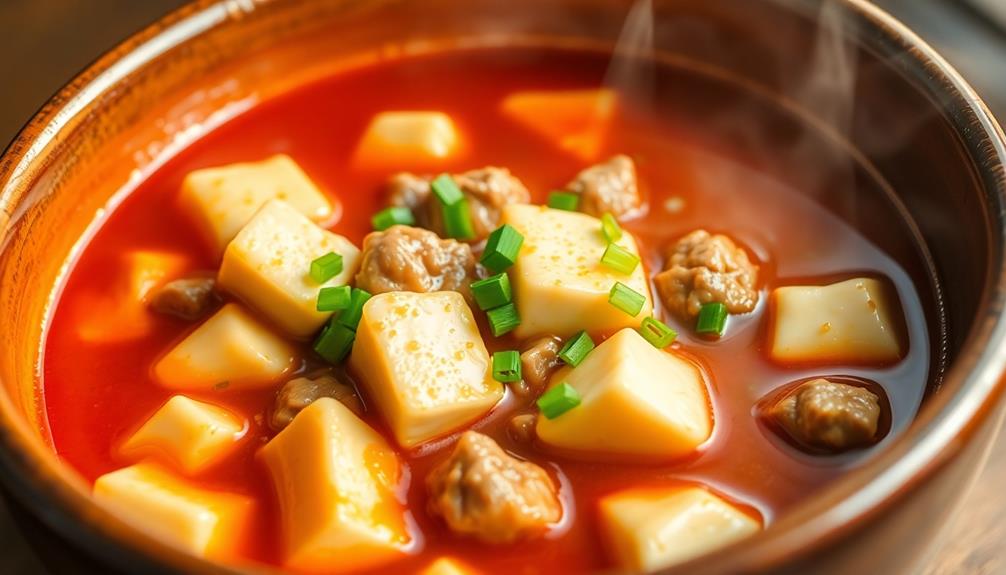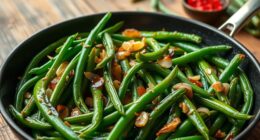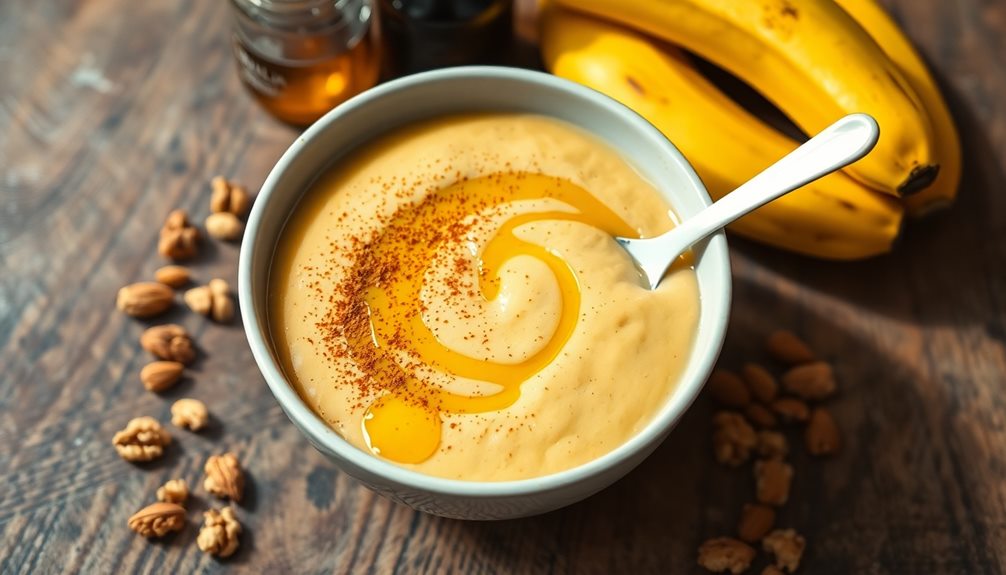Get ready for a truly delightful Chinese dish – Yangzhou fried rice! This time-honored recipe combines fragrant long-grain rice, tender proteins, and vibrant veggies for a harmonious flavor explosion. The secret lies in expert preparation and stir-frying techniques that bring out the best in every ingredient. You'll love the savory, salty, and umami notes, plus the contrasting textures that'll make your taste buds dance. Customize it to your liking, and you'll understand why this beloved dish is a staple in Chinese cuisine enjoyed worldwide. Let's dive in and explore the fascinating history and cooking tips that make Yangzhou fried rice such a treat!
Key Takeaways
- Yangzhou fried rice is a traditional Chinese dish that originated in Yangzhou, Jiangsu province, known for its vibrant colors, tender texture, and delightful taste.
- The dish features a base of long-grain rice, eggs, and a variety of proteins such as diced ham, Chinese sausage, shrimp, or chicken, along with colorful vegetables.
- Crucial cooking techniques include using day-old rice, scrambling the eggs separately, and stir-frying over high heat to develop the flavors and achieve a crispy texture.
- The flavor profile of Yangzhou fried rice is a balance of savory, salty, and umami, with aromatic ingredients like scallions and garlic enhancing the overall taste.
- Yangzhou fried rice is a versatile dish that can be served as a main course or a side, and it can be customized to accommodate various dietary preferences or restrictions.
History
Yangzhou fried rice has a rich history dating back centuries. This beloved Chinese dish originated in the city of Yangzhou, located in the eastern province of Jiangsu. The recipe was first developed by skilled chefs who combined fragrant rice, fresh vegetables, and savory proteins to create a harmonious blend of flavors.
Over time, the dish evolved, with each cook adding their own unique touch, whether it was a sprinkle of sesame oil or a pinch of white pepper.
Today, Yangzhou fried rice is renowned for its vibrant colors, tender texture, and delightful taste. The key to its success lies in the careful selection and preparation of the ingredients. The rice must be perfectly cooked, the vegetables crisply sautéed, and the proteins expertly seasoned.
The result is a satisfying and comforting meal that has become a staple in Chinese cuisine. Whether you're enjoying it at a family gathering or a festive celebration, Yangzhou fried rice is a time-honored tradition that continues to delight palates around the world.
Recipe
Yangzhou Fried Rice is a classic Chinese dish that originated in the city of Yangzhou, Jiangsu province. This flavorful and versatile rice dish is a beloved staple in households and restaurants across China.
The key to exceptional Yangzhou Fried Rice lies in the careful selection and preparation of ingredients. Each component, from the fragrant rice to the savory meats and crisp vegetables, must be handled with precision to achieve the perfect balance of textures and flavors.
- Long-grain rice
- Eggs
- Diced ham or Chinese sausage
- Frozen peas
- Carrots, diced
- Scallions, sliced
- Garlic, minced
- Soy sauce
- Sesame oil
- Salt and white pepper to taste
Begin by cooking the rice according to package instructions. Spread it out on a baking sheet and let it cool completely.
In a large wok or skillet, scramble the eggs and set them aside. In the same wok, sauté the garlic, ham or sausage, carrots, and peas until fragrant and slightly tender.
Add the cooled rice and toss everything together. Season with soy sauce, sesame oil, salt, and white pepper, adjusting the flavors to your taste.
Finally, stir in the scrambled eggs and scallions, ensuring the ingredients are evenly distributed.
To achieve the perfect Yangzhou Fried Rice, it's essential to use day-old rice, as the drier texture helps create the signature crispy edges. Additionally, be mindful not to overcrowd the wok, as this can result in steaming the rice rather than frying it.
With a little practice, you'll be able to create this delightful dish that captures the essence of Yangzhou's culinary heritage.
Cooking Steps
Heat up your wok over a blazing high flame.
Toss in the scrambled eggs and let them sizzle for a bit.
Now add the chopped scallions – they'll give your fried rice a wonderful pop of flavor!
Step 1. Heat Wok Over High Flame

The wok's sizzling dance commences as you crank up the heat, preparing to unleash the flavors of this iconic dish. You can almost hear the eager sizzle as the empty wok is placed over the scorching flames, eagerly awaiting your culinary magic.
Make sure the heat is blazing – you want that wok piping hot and ready to work its alchemy.
Now, give the wok a quick swirl to coat the surface with a thin layer of oil. This helps create that perfect golden-brown crust on the rice. When the oil starts to shimmer and dance, you know it's time to add your ingredients.
Toss in the onions first, letting them sizzle and soften for a minute or two. The aroma will start to fill your kitchen, making your mouth water in anticipation.
Next, add the rest of your veggies and proteins, stirring constantly to ensure everything cooks evenly. Keep that wok rocking and rolling until each morsel is hot, tender, and infused with flavor.
Step 2. Add Scrambled Eggs
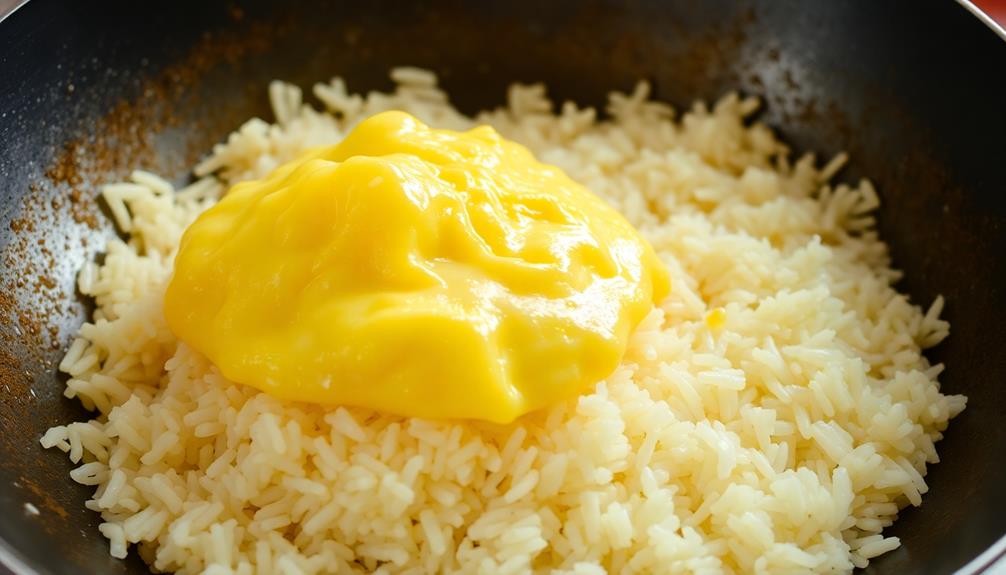
As the vegetables and proteins sizzle away, it's time to incorporate the scrambled eggs.
Crack a few fresh eggs into a small bowl and give them a good whisk with a fork until they're nicely beaten.
Now, create a well in the center of your wok and pour in the eggs. Let them sit for a moment, then use your spatula to gently push the eggs from the edges towards the center, folding and stirring as you go.
This will allow the uncooked egg to flow to the hot surface, ensuring your scramble turns out light and fluffy.
Keep a close eye and continue this folding motion until the eggs are just set but still moist. Be careful not to overcook!
Once the eggs are ready, give the whole mixture a final stir to evenly distribute them throughout the fried rice.
The contrast of the soft, creamy eggs with the other tasty ingredients is simply divine.
Step 3. Add Chopped Scallions
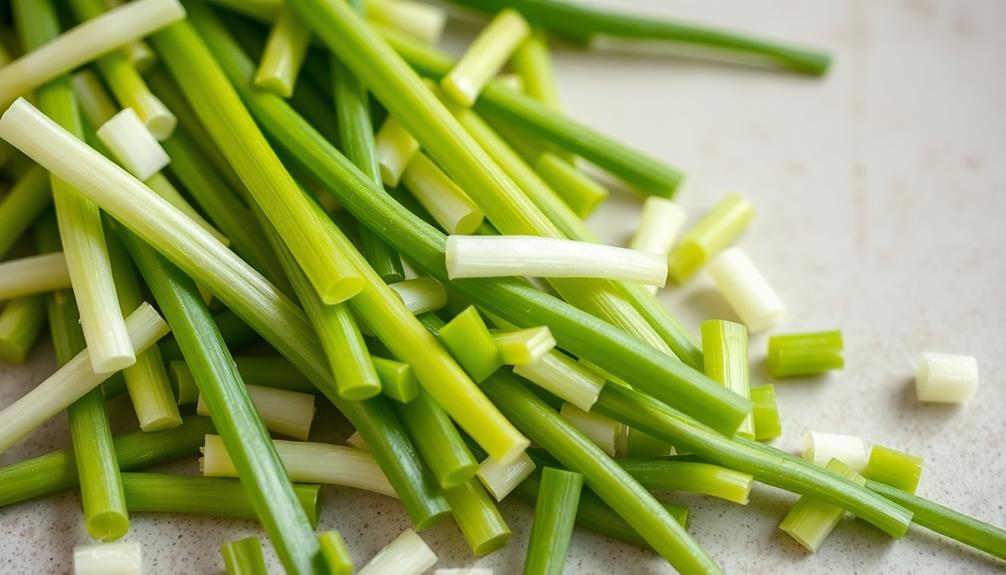
With the scrambled eggs now incorporated, it's time to add the chopped scallions. These vibrant green onions will add a lovely fragrance and subtle flavor to your Yangzhou fried rice.
Grab a bunch of scallions and give them a good wash. Trim off the root ends and the tough, dark green tops, leaving you with the bright, tender parts. Slice the scallions crosswise into small, thin pieces, about 1/2 inch long. This will ensure they cook quickly and distribute evenly throughout the dish.
Toss the chopped scallions into the wok or skillet, right on top of the eggs. Use your spatula to gently stir and incorporate them. The scallions will sizzle and become aromatic as they cook briefly with the other ingredients.
Their fresh, oniony taste will complement the savory eggs and rice perfectly. Keep stirring until the scallions are softened but still vibrant green, about 1 minute.
Now your Yangzhou fried rice is really coming together! Next, you'll add the cooked rice to finish the dish.
Step 4. Add Cooked Rice
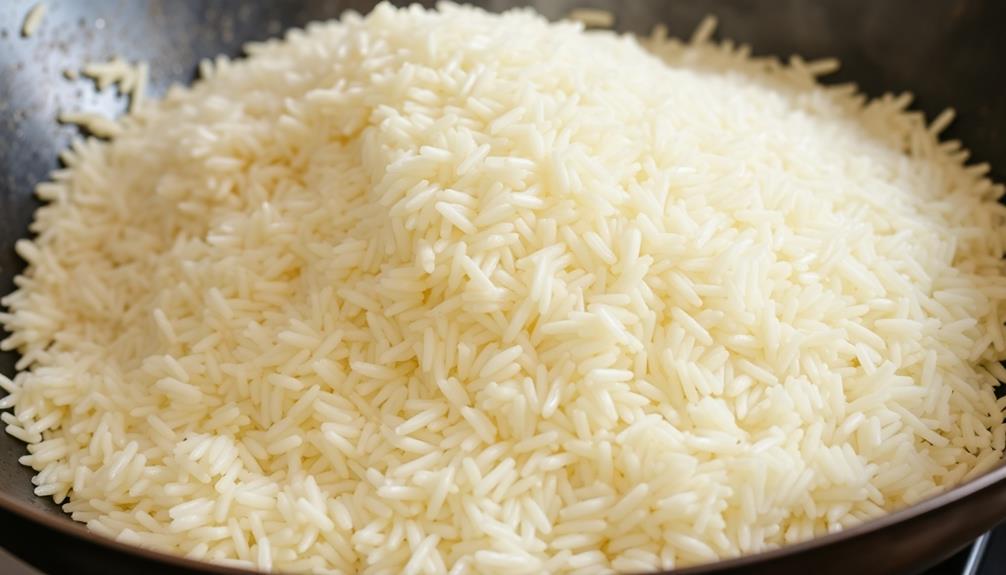
Grab the cooked rice and toss it right into the wok or skillet. You want to get that rice moving and mixing with all the delicious ingredients already in there.
Don't be shy – really give it a good stir so every grain gets coated. The key is to keep the rice moving, not letting it sit in one spot and get soggy. As you stir, you'll see the rice start to sizzle and turn a beautiful golden color. That's exactly what you're going for!
Keep stirring for a minute or two until the rice is heated through and has a nice, even texture. Now it's time to add a splash of soy sauce. Just a drizzle will do – you don't want to overpower the other flavors.
Give it one more good toss, and your Yangzhou fried rice is ready to serve! Doesn't it smell amazing?
Step 5. Stir and Toss Until Fully Combined

Vigorously stirring and tossing the rice ensures every grain is thoroughly coated with the delicious flavors.
Using your trusty spatula, give the rice a good mix, making sure to scrape up any bits stuck to the bottom of the pan.
Don't be shy – really work those grains, flipping and folding them over each other. You want to see the rice start to glisten as the oil and seasonings distribute evenly.
Keep at it for a minute or two, until you can't spot any clumps or dry patches.
The key is to handle the rice gently but with purpose, treating each grain like a precious jewel.
With the perfect balance of softness and separation, your Yangzhou fried rice is well on its way to greatness. The vibrant mix of fresh vegetables, tender proteins, and fragrant rice creates a delightful harmony in every bite. To complete the meal, you might consider ending on a sweet note with tangyuan traditional Chinese dessert—soft, glutinous rice balls filled with either sesame, peanut, or red bean paste, offering a rich contrast to the savory elements of the fried rice. This blend of textures and flavors brings a comforting sense of balance to the entire dining experience.
Just a little more effort, and you'll have a fragrant, flavor-packed dish that'll have everyone coming back for seconds!
Final Thoughts
Yangzhou fried rice is a delightful and versatile dish that can be enjoyed in a variety of ways. Whether you're serving it as a main course or a side, the combination of savory flavors and textures is sure to delight your taste buds.
Don't be afraid to get creative and experiment with different ingredients to suit your own preferences. The great thing about Yangzhou fried rice is that it's endlessly customizable, so you can make it your own! Add in some diced vegetables like bell peppers, carrots, and peas for added color and nutrition. For a protein boost, throw in some cooked chicken, shrimp, or tofu. With these simple additions, you can create a flavorful homemade fried rice that is completely unique to your tastes.
As you've learned, the key to making the perfect Yangzhou fried rice is in the technique. By stir-frying the ingredients and tossing the rice until it's fully combined, you'll end up with a dish that's bursting with flavor and perfectly cooked.
Frequently Asked Questions
Is Yangzhou Fried Rice Suitable for Vegetarians?
Yes, you can make Yangzhou fried rice suitable for vegetarians. Simply substitute the meat with your favorite vegetables and tofu. This versatile dish can easily be adapted to accommodate a vegetarian or vegan diet.
How Long Does It Take to Prepare Yangzhou Fried Rice?
Preparing Yangzhou fried rice typically takes around 30-45 minutes. You'll need to cook the rice, chop the vegetables, and sauté everything together to get that authentic flavor. It's a quick and delicious dish that's worth the effort.
Can I Make Yangzhou Fried Rice in Advance?
You can make the dish in advance, but it's best to cook the rice fresh and assemble the components right before serving. This will ensure the texture and flavors are at their peak when you enjoy your meal.
What Are the Common Variations of Yangzhou Fried Rice?
Common variations of this dish include using different proteins like shrimp, chicken, or beef. You can also add vegetables like peas, corn, or carrots. Some cooks even use leftover fried noodles for an extra crunch.
Where Can I Find the Best Yangzhou Fried Rice in Yangzhou?
To find the best Yangzhou fried rice in Yangzhou, you'll want to explore the city's local restaurants and street vendors. Ask locals for their recommendations, as they'll know the top spots for this signature regional dish.
